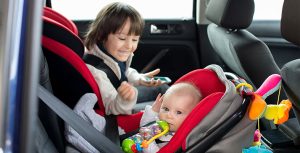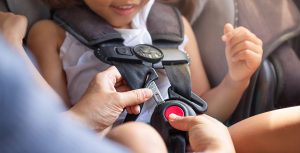
Car crashes are one of the leading causes of death for children in the United States. While car crash statistics are not known for 2022 just yet, the number from previous years are chilling. For example, in 2019, 1053 children under the age of 14 were killed, and around 183,000 were injured in motor vehicle crashes.
The vast majority of these deaths and injuries could have been prevented with the proper use of car seats and booster seats. The good news is that the use of these devices has been on the rise in recent years. However, in 2022, many parents and caregivers are still not using them correctly.
We know that taking care of a baby is a big responsibility, and we want to help make it as easy as possible for you. Part of that is having access to professional and reliable info provided by certified experts who went through the same experiences. Visit the Newborn course category to find the answers you’re looking for.

NHTSA shares the data from 2019 in their Traffic Safety Fact sheet published in March 2022:
—Child safety seats have been shown to reduce fatal injury by 71 percent for infants (under 1 year old) and by 54 percent for toddlers (1 to 4 years old) in passenger cars. For infants and toddlers in light trucks, the corresponding reductions are 58 percent and 59 percent, respectively.
A car seat is one of your most important purchases for your child. It is also one of the most misunderstood and misused products.
One of the most common mistakes is facing a child forward in a car seat too soon. The American Academy of Pediatrics (AAP) and the National Highway Traffic Safety Administration (NHTSA) recommend that all children ride in a rear-facing car seat until they at least pass the 1-year-old mark, but preferably until they reach the height or weight limit for their seat.
After that, they should ride in a forward-facing car seat with a harness for as long as possible, up to the maximum height and weight for their seat. Booster seats should be used after a child outgrows their forward-facing car seat until they are big enough to use a seat belt alone.
Each state has its own laws regarding car seat usage, so be sure to check the requirements in your state. You can find a list of state car seat laws here.
The general rule of thumb is that a baby can face forward in a car seat when they are at least one year old.
However, it is best to wait longer than that: until your child has outgrown the height or weight limit for their rear-facing car seat. A rear-facing car seat can support a child up to 3 years old.
It is better to wait before transitioning to a front-facing car seat because young children’s skulls are not fully developed, and they are more susceptible to head and neck injuries in a car accident. The rear-facing car seat is safer for them because it provides more support for the head and neck.
If your child is under two years old, you should consult your pediatrician before switching to a front-facing car seat. They may have specific recommendations for your child based on their health and development.
In 2022, the recommendation for a child to face forward in a car seat is a minimum of 20 pounds. The end limit varies depending on the car seat model but oscillates around 80 pounds.
However, it is best to wait until your child reaches the maximum weight for their previous car seat before making the switch.

There are several reasons why rear-facing is the safest option for the youngest children. First, it provides the best protection for the head, neck, and spine in the event of a crash. In a rear-facing position, the force of a collision is evenly distributed across the back of the car seat, which acts as a buffer for the child’s head and body.
In contrast, in a forward-facing position, the force of a crash is concentrated on the child’s head and neck, which can lead to severe injury or even death. In fact, a child in a forward-facing seat is five times more likely to suffer a serious neck injury in a crash than a child in a rear-facing seat.
Another reason rear-facing is safer is that it keeps the child’s head, neck, and spine in alignment. In a rear-facing position, the car seat supports the entire head and back, which helps to prevent the neck from being snapped forward or sideways in a crash.
Finally, rear-facing seats are more stable than forward-facing seats in a crash. This is because they are anchored to the vehicle at two points rather than just one. This makes it less likely for a rear-facing seat to be thrust forward or sideways in a crash, which can cause serious injury to the child.
Changing into a face forward position too early puts babies and toddlers at increased risk of severe injury or death in the event of a crash. It is essential to keep your child rear-facing for as long as possible, at least until they reach the maximum height and weight for their car seat.
After that, they can switch to a forward-facing seat with a harness. But even then, the child should remain in a booster seat until they are big enough to use a seat belt alone.

You should keep a few things in mind to ensure your child is as safe as possible when riding in a car seat. First of all, make sure the seat is correctly installed. The NHTSA has a helpful guide on how to install a car seat.
Secondly, be sure to read the instructions that come with your car seat. Every seat is different, and it’s essential to follow the specific instructions for your seat.
Third, make sure your child is properly buckled in. The harness should be snug against the child’s body, and the chest clip should be at armpit level.
Finally, don’t forget to register your car seat. This will ensure that you are notified of a recall on the seat. You can register your car seat here.
Most car seats have an expiration date of six years from the date of manufacture. After that, the seat may not provide adequate protection in a crash.
It’s also important to remember that car seats can expire even if they haven’t been used. This is because the materials in the seat can degrade over time, affecting the seat’s performance in a crash.
If you’re unsure when your car seat expires, you can check the date on the sticker that is usually located on the back of the seat. If you can’t find the sticker, you can contact the manufacturer to determine when the seat was manufactured.
Once a car seat expires, you should replace it with a new one. You can usually find car seats on sale at your local store or online.
The position of the seat belt on a car seat is important for the child’s safety. The lap portion of the seat belt should be positioned low and tight across the child’s hips and upper thighs. The shoulder portion of the seat belt should be placed over the child’s shoulder, not under the arm or behind the back.
Installing a car seat correctly is essential for the child’s safety. The seat should be in the correct position, and the seat belt or LATCH system should be tightly fastened.
The NHTSA has a helpful guide on how to install a car seat. You can also find instructions on how to install a car seat in the car seat’s manual.
If you’re not sure if the seat is installed correctly, you can take it to a local certified car seat inspection station. Thanks to Safe Kids Worldwide, you can find certified CPS technicians in your area by filling out a simple online form.
Some police and fire departments also offer car seat inspections. You can call your local department to see if they provide this service.
Most rear car seats have a height limit of 30-32 inches. After a child outgrows the height limit for a rear-facing seat, they can switch to a forward-facing seat with a harness.
The rule in 2022 is that the child’s head should be at least an inch below the top of the seat when they are in the seat. If the child’s head is higher than the seat, they may not be properly protected in a crash.
The weight limit for a car seat is the maximum weight that the seat can safely accommodate. It’s important to check the weight limit of your seat, as exceeding the limit can put your child at risk.
You might ask: What do airbags have to do with toddlers’ safety?
Airbags are designed to protect adults in a crash but can be dangerous to children. That’s why keeping children in the back seat, properly restrained in a car seat or booster seat, is essential.
Never put a rear-facing car seat in the front seat of a car with an active passenger airbag. The force of an airbag can cause serious injuries or even death to a child in a rear-facing car seat.
Disable the airbag if you have to use a forward-facing car seat in the front seat. You can usually do this by turning a switch near the steering wheel.

Here are some tips to keep in mind when using a car seat:
Following these tips will help to ensure that your child is safe and secure in their car seat.